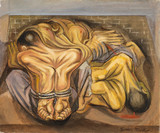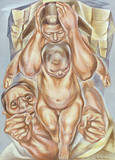Trained as a figure painter, Bendor Mark has devoted most of his art to political statements. Born Bernard Marcus and raised in Brooklyn, he studied art with William Brantley Van Ingen (b. 1858) at the Cooper Union in the late 1920s. During the early 1930s he supported himself as a textile designer. He became an activist, joining the Artists Union formed in 1934 to strengthen the artist’s position as a worker, and participated in the Federal Art Project. Mark’s work reflected political issues and became associated with the social realists’ in criticizing national ills and international problems. In 1937 he painted a series condemning the exploitation of mine workers and exhibited one of the scenes at the 1939 New York World’s Fair. Around 1939 he began to propose mural projects heavily influenced ideologically and stylistically by the Mexican muralists; none of these, however, was ever realized. It was about this time that he assumed the name Bendor Mark to distinguish his politically inspired work from his early art. He became active in Queens, teaching adult art classes and supporting the Flushing Art Center. During World War II he prepared classified drawings for army contractors and when the fighting ended continued to work as a graphic artist. From 1945 until his move to Southern California in 1948 he worked in the printing industry. In 1949 he resumed painting, and his art thereafter was as politically oriented as before. After moving to California he resided first in Los Angeles but eventually settled in La Jolla. Around 1955 his work began to be rejected from exhibitions, and he consequently withdrew from the public eye. Thereafter his political paintings became increasingly satirical.
BIBLIOGRAPHY
Archiv. Am. Art, Bendor Mark Papers (not on microfilm) § Who’s Who in American Art, 1947, 1953, 1972, 1984, s.v. "Mark, Bendor."

